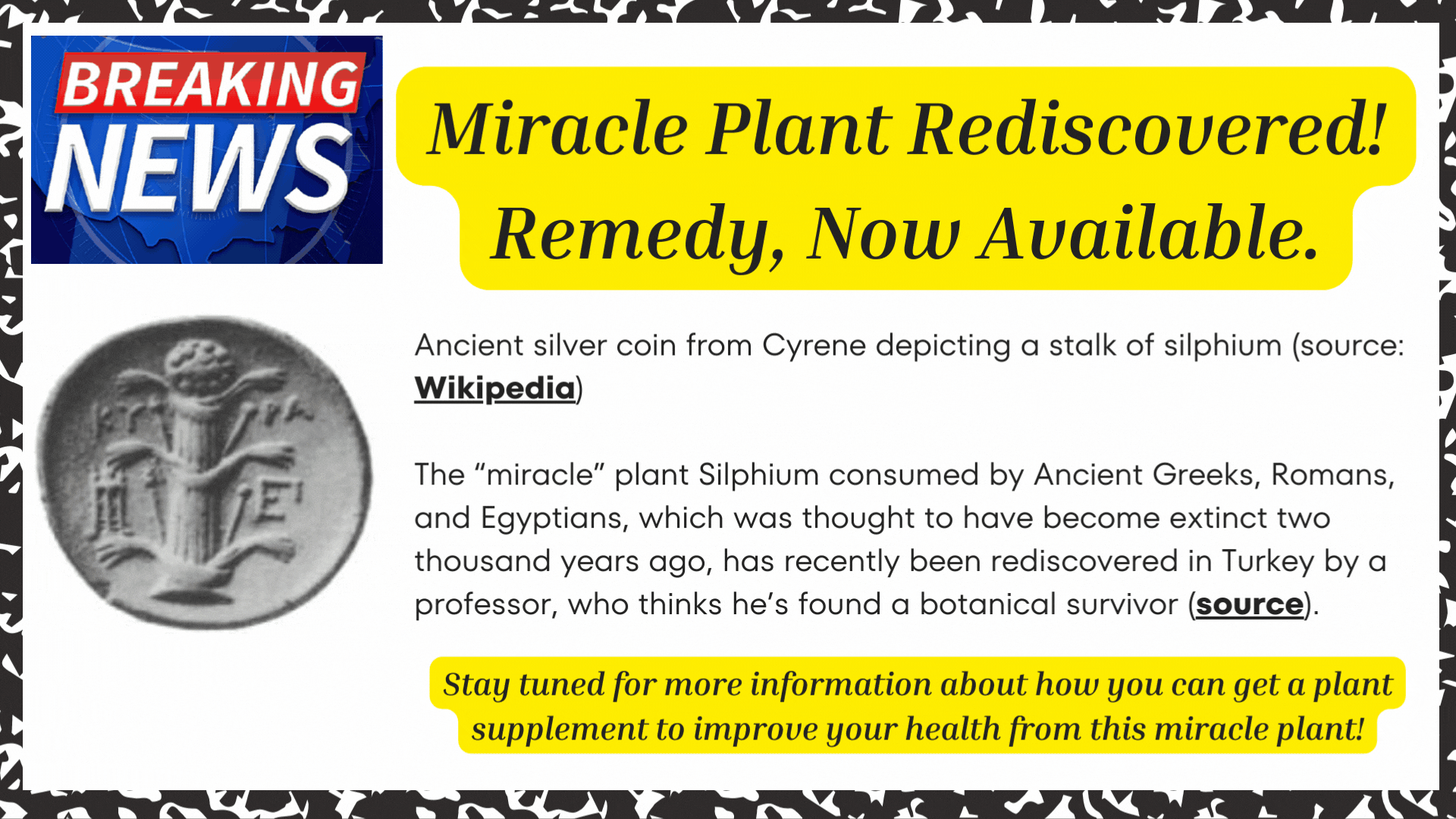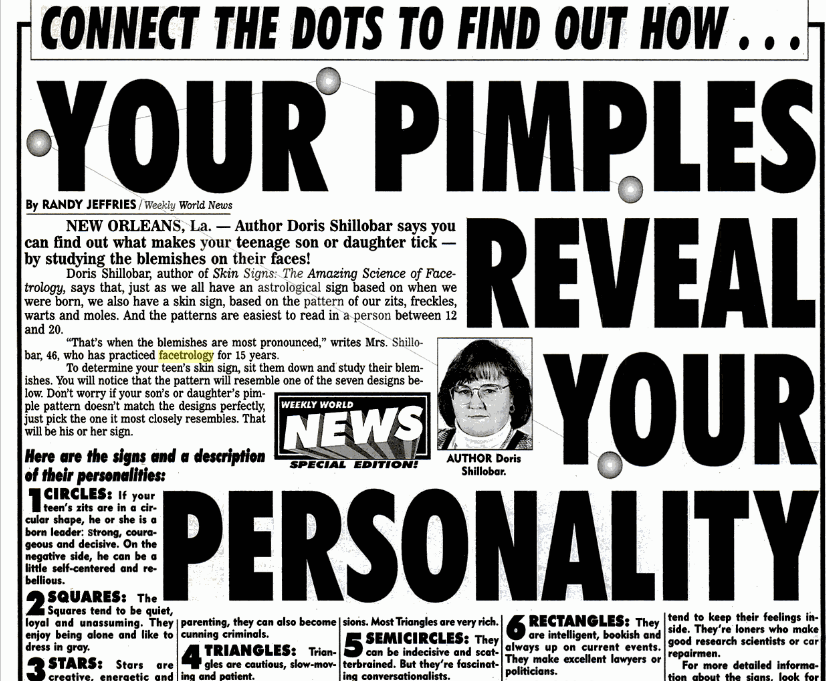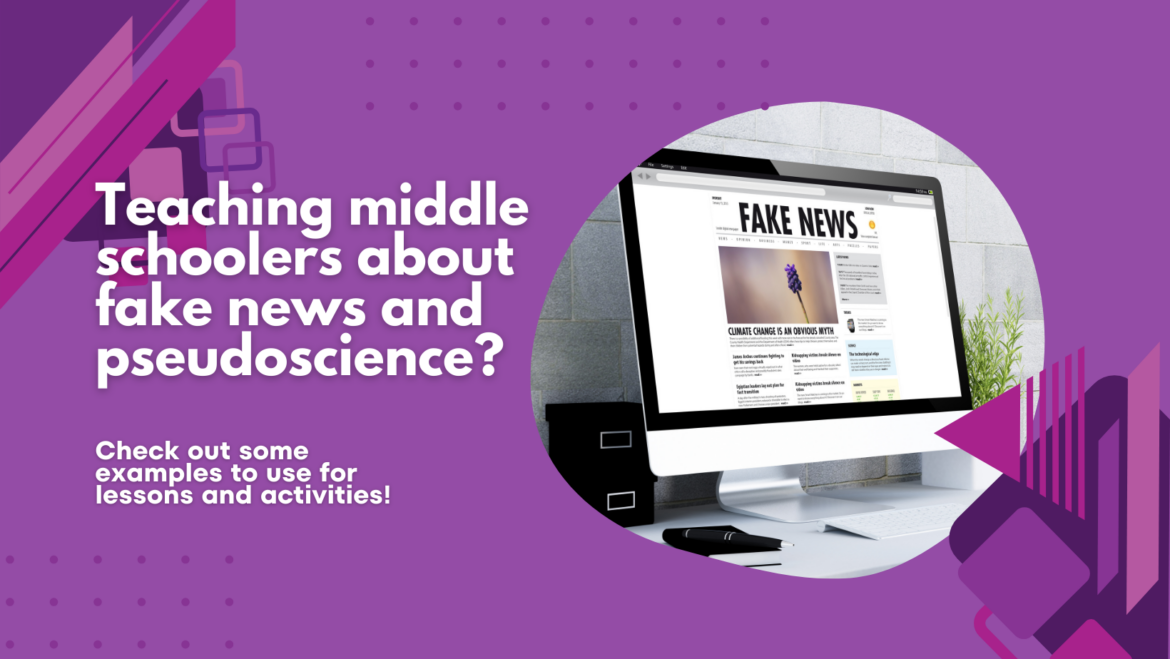Are you watching students and colleagues make claims based on potentially unverified information they’ve encountered? How can we balance all the information we receive from various outlets with a solid, decision-making process? Let’s explore some sources you can use to teach middle school students the importance of fact-checking and critical thinking. You’ll also discover an exciting new product, The Silph Booster, guaranteed to solve any child’s school cognition problems.

“We think we follow evidence to a conclusion. In reality, we come to our beliefs in irrational ways, then work backwards to find evidence to rationalize the belief. Pseudoscience is the promotion of a non-scientific theory. It is motivated by wishful thinking, existing beliefs, or identity.”
Melanie Trecek-King
Asking Tough Questions
Teachers and librarians may very well ask tough questions like these:
- How should professionals address the issues of fake news, pseudoscience, propaganda, and/or biased research?
- What happens when state organizations push biased information?
- What are the best ways to use digital tools to support critical thinking today?
- What are the requisite critical thinking skills that consumers and creators need?
These are tough questions that educators wrestle with. One possibility is changing how you think of it. Pseudoscience is a “by-product of normal science,” and this video is a bit of an eye-opener on the BENEFITS of pseudoscience.
Defining Fake News and Pseudoscience
Fake news is made-up information that’s given the appearance of real, legitimate news. Pseudoscience is fabricated and made to look like real science information. But both are designed to fool you or make you accept something that’s false as truth (adapted from source). How can we teach about this in grades 5-8? And, how might we even encourage the analysis of the design of pseudoscience? Before we get to that, let’s revisit an old bit of pseudoscience you may be familiar with.
Take a moment to watch this video about fake news (or this one). Share your responses to the questions in the comments.
Using Easy-to-Disprove Stories to Teach Critical Thinking
Many start teaching students about fake information using easy-to-disprove stories. For example, the tree octopus site has long served as an example of pseudoscience.
The Pacific Northwest tree octopus is an Internet hoax created in 1998 by Lyle Zapato. This fictitious endangered species of cephalopod was purportedly able to live both on land and in water. It was said to live in the Olympic National Forest and nearby rivers, spawning in water where its eggs are laid. Its major predator was reported to be the Sasquatch. The Pacific Northwest tree octopus website is among a number of sites commonly used in Internet literacy classes in schools, although it was not created for that purpose. (source)
Back in the 1990s, this bit of lore was old. It’s pseudoscience, even if old, that stirs a chuckle or two. I remember sharing it at “Intro to the Internet” workshops for teachers. Back then, it was about encouraging people to look twice, analyzing the website, before trusting what they found. It soon evolved into a funny way to introduce students to silly, fake facts. Finding out what’s actually true or not with more realistic information is a lot harder. Let’s take a look at some other story examples you can use for teaching.
Check out this lesson plan…
Here’s a middle school lesson plan aligned to NGSS standards. Students explore the characteristics of science and pseudoscience.
“You have to disentangle the details. You have to hold up every one independently, and ask, ‘How do we know this detail? Where are all these details coming from? Where did that specific detail come from?”
Eliezar Yudkowsky
Example #1: Saving Critical Cash Crops
Did you know you can harvest spaghetti noodles? Watch this video and consider the story of spaghetti cultivation and harvest.
This is a delightful tale about how spaghetti noodles find their way to your plate. Want a more up-to-date example? Explore how climate change is impacting farming. Heavy rains are jeopardizing this cotton candy farm, blue strawberries, and marshmallow fruit trees. Have students brainstorm solutions to save these cash crops.
“Most people, in fact, will not take trouble in finding out the truth, but are much more inclined to accept the first story they hear.”
Thucydides
Example #2: Sea Monsters and Whales in the Great Lakes
Explore the enchanting yarn of the Nantucket Sea Monster. Or see how many people have observed whales in the Great Lakes.
It’s incredible to see videos like this one, right? More pictures are available.
“Each year we report the movements of the whales on Lake Superior. The reports are sightings sent by residents and visitors along the North Shore of Lake Superior. If you spot whale activity, let us know by filling out the form on the right! We accept photos, too.”
“What can be asserted without evidence can also be dismissed without evidence.
Christopher Hitchens (a.k.a. “Hitchen’s Razor”)
Example #3: Pig Hero Rescues Baby Goat
It’s not every day you see amazing pig rescues. Once you watch this, you realize how powerful a video is to capture just-in-time acts of heroism.
This video provides some more insights into the creation of the goat rescue. What do you think?
Fake News Isn’t New
Amazing enough, fake news isn’t a recent affliction. You can watch this video to learn more about fake news in the 18th century. This video features a particularly interesting maternal claim. Watch the video to learn more.
Extraordinary claims require extraordinary evidence.
Carl Sagan (a.k.a. “Sagan’s standard”)
Example #4: Mike the Headless Chicken
Can you imagine a chicken living without its head? If you aren’t familiar with this bit of lore, you’ll want to check it out.
On September 10, 1945, farmer Lloyd Olsen of Fruita, Colorado, was planning to eat supper with his mother-in-law. He was sent out to the yard by his wife to bring back a chicken. Olsen chose a five-and-a-half-month-old Wyandotte chicken named Mike.
Mike, the chicken was still able to balance on a perch and walk clumsily. He attempted to preen, peck for food, and crow, though with limited success.
We are trying to prove ourselves wrong as quickly as possible, because only in that way can we find progress.
richard feynman
Example #5: Nut Milking
Find out the truth behind that almond, cashew, and pistachio milk you’ve been buying at the store. In this three-minute documentary, you and your students will be startled. You’ll learn what it takes to milk nuts, not unlike cows.
It is morally as bad not to care whether a thing is true or not, so long as it makes you feel good, as it is not to care how you got your money as long as you have got it.
Edmund way teale, circle of the seasons (1950)
A Few Books on the Subject
Want to beef up your knowledge on the subject of fake news and pseudoscience? Check out these books to broaden your perspective and deepen your knowledge. You will also find some more examples of stories you and your students can analyze.
- Killer Underwear Invasion! by Elise Gravel
- Developing Digital Detectives: Essential Lessons for Discerning Fact from Fiction in the ‘Fake News’ Era by Jennifer LaGarde and Darren Hudgins
- Fact Vs. Fiction: Teaching Critical Thinking Skills in the Age of Fake News by Jennifer LaGarde and Darren Hudgins
Here are some specific books that feature examples of lies:
- Two Truths and a Lie: It’s Alive! by Ammi-Joan Paquette, Laurie Ann Thompson, and Lisa K. Weber
- The Nantucket Sea Monster: A Fake News Story by Darcy Pattison and Peter Willis
Want more resources? Explore this Wakelet by high school teacher, Julie Drewry. She does a wonderful job wrapping up stories and ideas, some of which I’ve included in this blog entry.
Give Fakey a Try
You will find interesting scenarios, some of which may highlight toxic practices in education and/or work place. Be sure to preview the scenarios to see if they are appropriate for your situation. Play the game.
Mistrust arguments from authority. In science, there are no forbidden questions, no matters too sensitive or delicate to be probed, no sacred truths.
Carl Sagan
Make Up Your Own Fake News and Pseudoscience
Wouldn’t it be a hoot to create your own fake news and pseudoscience for teaching purposes? I know it is because I’ve written fake news articles about family, friends, and colleagues. Although read by a limited audience, I still remember the time I wrote one about a principal. Ahem, well, no need to go into details. If you need some inspiration, clickbait and April Fool’s jokes are great sources for ideas.

Source: Connect the Dots: Pimple Personality Test in Weekly World News, 1999
Seven Steps to Creating Pseudoscience
To construct your own pseudoscience, Robert T. Carroll has some suggestions. With those for inspiration, I’ve boiled them down to seven steps:
- Make big promises about the scientific proof for something that most people fear (e.g. death, pain) or desire (e.g. money, health, long life).
- Use a lot of jargon and hedge your promises with words like “may help.”
- Reference conspiracies that try to keep the truth from the public.
- Claim you have discovered a secret scientists are unaware of.
- Make stuff up and include testimonials from famous people with big names.
- Charge for your product.
- Wear a lab coat and call yourself a doctor.
How could we put these suggestions to good use?
The Silph Booster, Now Available
Want a quick example that takes real news and science but twists it into pseudoscience? Let’s see…did you know about this new booster to your health, the Silph Booster? It’s especially effective given its long history from ancient times. The original plant on which this solution was based was lost. But it has been recently rediscovered!

Ancient silver coin from Cyrene depicting a stalk of silphium (source: Wikipedia)
The “miracle” plant Silphium consumed by Ancient Greeks, Romans, and Egyptians, which was thought to have become extinct two thousand years ago, has recently been rediscovered in Turkey by a professor, who thinks he’s found a botanical survivor (source).

Are your students having problems getting along in school? Are their grades in core content areas slipping? That may be due to commensal septimedia, a condition recently discovered in grades 5-12. It is the direct result of social media usage and exposure to digital media in schools.
While students may endure it for years without visible effect, it can manifest to bad result. To address it, you will need a powerful herb popular in classical Greek and Roman times. The herb is silphium, and it is now available as a dietary supplement, ingestible as a capsule. Five capsules a day, three at breakfast and two at dinner, will have an immediate salutary effect. Scientists at a prestigious nonprofit education organization have conducted ground-breaking, longitudinal research. The curative impact of the Silph Booster cannot be overstated.
This miracle plant supplement has been kept secret for thousands of years. Fortunately, scientists in the lab at TCEA Science Institute of Technology made a breakthrough that allows us to bring it to you in four easy payments of $35 each for a bottle of 100 capsules. Call 1-800-282-8232 and ask for Chief Researcher, Miguel Guhlin, for details. The Silph Booster is currently only available for youngsters under parental supervision. A stronger formula for K-16 educators is under development. Order now. Government agencies, like the Food and Drug Administration (FDA), want to keep America dumb, so they are fighting to stop production in the United States. For a limited time, you can order the European version of the booster, which features a stronger formula.
Critical Thinking Is Unnatural, Yet Necessary
“We have to keep reminding ourselves that critical thinking is an unnatural act,” says Carroll. And, I can’t disagree. Every time I find myself falling for pseudoscience, or failing to ask tough questions, I sigh. Like reading, critical thinking is something you practice to get better at. Two quick acknowledgments:
- The Silph Booster is a fake product.
- Special thanks to Lisa Toner in the Future Ready Librarians group for inspiring this post with her question.

